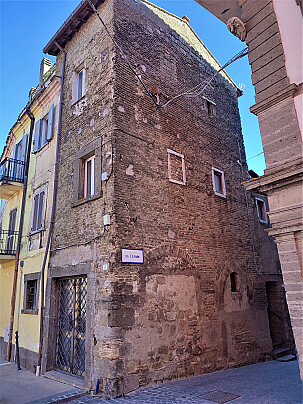Casa Torre Medievale
Fortificazione/residenza storica (XIII-XIV sec.)
ITA
Casa Torre Medievale
Fortificazione/residenza storica (XIII-XIV sec.)
Nella seconda metà del XIII secolo si diffusero a Campagnano un gran numero di edifici fortificati, torri e case-torri a imitazione di quell’esperienza di un secolo precedente che vedeva nella nascita delle torri della Campagna Romana l’affermazione dei signorotti su ampi territori e lungo le vie di comunicazione. Non siamo sempre certi che le case-torri come quella che hai di fronte fossero realmente progettate per estrema difesa militare di un quartiere o di un crocevia, anche se interno al più ampio castrum, ma di sicuro questi edifici avevano sempre un carattere di autonomia e indipendenza della singola famiglia che la realizzava, anticipando i palazzetti nobiliari del rinascimento. Al suo interno c’era solitamente il pozzo per la raccolta dell’acqua piovana e il butto per scaricare i rifiuti, le cucine e le dispense, uno spazio per gli animali e una struttura verticale in grado di poter avvistare segnali di pericolo provenienti da altri punti elevati nel territorio. Le case-torri come questa hanno subito varie trasformazioni nel corso del tempo, adeguandosi di volta in volta alle necessità residenziali della piccola nobiltà urbana che le possedeva, ma questa ancora dimostra, sul versante settentrionale, una decorazione a loggette della cornice marcapiano del primo solaio tipica del XIV secolo.
<- Via del Duomo - Quartiere Medievale
Fontana dei Delfini - Museo Archeologico del Pellegrino ->
ENG
Medieval Tower House
Fortification/historic residence (13th – 14th century)
In the second half of the 13th century a large number of fortified buildings, towers and tower-houses spread throughout Campagnano in line with the experience of the previous century when towers were built in the Roman countryside as the affirmation of lords over large territories and along the communication routes. Although there is no certainty that tower-houses like this one were really designed for the military defence of a district or a crossroads, even if inside a larger castrum, these buildings certainly always expressed the autonomy and independence of the families that built them, forerunners of the noble palaces of the Renaissance. Inside there was usually a well for collecting rainwater and a hole for discharging waste, kitchens and pantries, a space for animals and a vertical structure needed to detect any sign of danger from other high locations in the area. Tower-houses like this one have undergone transformations over time, adapting from time to time to the residential needs of the minor urban nobility who owned them, but this still one presents, on its northern side, a decoration with loggias on the string course frame of the first floor typical of the 14th century.
<- Via del Duomo - Medieval Quarter
Fountain of the Dolphins - Archaeological Museum of the Pilgrim ->

